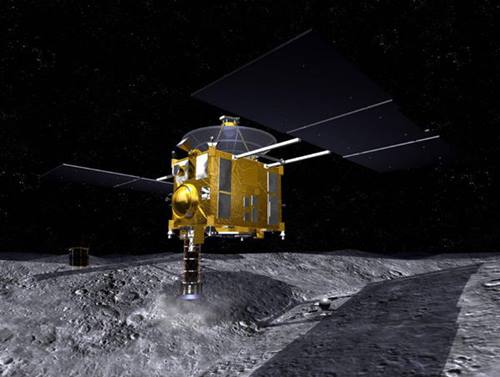[sc:text486 ]
TOKYO:- Japan successfully launched a probe destined for a distant asteroid on a six-year mission, just weeks after a European spacecraft’s historic landing on a comet.
The explorer, Hayabusa 2, blasted off aboard Japan’s main H-IIA rocket from Tanegashima Space Center in the south of the country.
The rocket roared up out of the Earth’s gravitational pull trailed by orange flames at 1:22 pm (0422 GMT) after launch delays due to bad weather.
Hayabusa2 was successfully separated from the H-IIA and entered the intended orbit around the planet at the start of its mission, according to the Japan Aerospace Exploration Agency (JAXA).
The probe will use the Earth’s gravity as a slingshot to propel it towards its target.
Television footage showed JAXA crew at ground control clapping as the launch was confirmed a success, while social media users around the world tweeted their congratulations.
The 31-billion-yen ($260-million) project will send the explorer towards the 1999JU3 asteroid in deep space.
It will blast a crater in the asteroid to collect materials unexposed to millennia of wind and radiation, in the hope of answering some fundamental questions about life and the universe.
It is expected to reach the asteroid in mid-2018 and spend around 18 months in the area.
It will also drop tiny MINERVA-II rover robots as well as a French-German landing package named Mobile Asteroid Surface Scout (MASCOT) for surface observation.
If all goes well, asteroid samples will be returned to Earth in late 2020.
The carbonaceous asteroid is believed to contain organic matter and water, the stuff of life.
Analysing the extra-terrestrial materials could help shed light on the birth of the solar system 4.6 billion years ago and offer clues about what gave rise to life on Earth, scientists have said.
The Hayabusa2 mission blasted off weeks after the European Space Agency succeeded in making the first-ever landing on a comet in November.
Scientists said initial data sent from the robot lab Philae showed traces of organic molecules and a surface much harder than imagined.
Philae, released from its mothership Rosetta, has gone into hibernation on comet 67P/Churyumov-Gerasimenko, having used its onboard battery power after 60 hours of prodding and probing.
JAXA aims to bring 100 milligrams (1/286th of an ounce) of samples to Earth after a round trip of more than five billion kilometres.
The probe is the successor to JAXA’s first asteroid explorer, Hayabusa — the Japanese term for falcon — which returned to Earth in 2010 with dust samples after a trouble-plagued seven-year mission.
The spherical 1999JU3 asteroid, which is around a kilometre (half a mile) across, is believed to contain significantly more organic matter and water than the potato-shaped rock studied by the original Hayabusa.
Despite various setbacks during its epic seven-year odyssey, including intermittent loss of communication and damage to its motors, the first Hayabusa was hailed as a scientific triumph when it returned to Earth.
-AFP
[sc:textfull ]

















